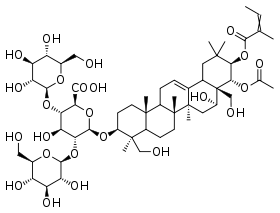Aescin
Aescin or escin is a mixture of saponins with anti-inflammatory, vasoconstrictor and vasoprotective effects found in Aesculus hippocastanum (the horse chestnut). Aescin is the main active component in horse chestnut, and is responsible for most of its medicinal properties. The main active compound of aescin is β-aescin, although the mixture also contains various other components including α-aescin, protoescigenin, barringtogenol, cryptoescin and benzopyrones.[1]
 | |
| Names | |
|---|---|
| IUPAC name
(2S,3S,4S,5R,6R)-6-{[(3S,4S,4aR,6aR,6bS,8R,8aR,9R,10R,12aS,14aR,14bR) | |
| Other names
Escin | |
| Identifiers | |
| |
3D model (JSmol) |
|
| ChEMBL | |
| ChemSpider | |
| ECHA InfoCard | 100.027.164 |
| KEGG | |
PubChem CID |
|
| UNII | |
| |
| |
| Properties | |
| C55H86O24 | |
| Molar mass | 1131.269 g·mol−1 |
Except where otherwise noted, data are given for materials in their standard state (at 25 °C [77 °F], 100 kPa). | |
| Infobox references | |
Evidence suggests that aescin, especially pure β-aescin, is a safe and effective treatment for short-term treatment of chronic venous insufficiency;[2][3] however, more high quality randomized controlled trials are required to confirm the effectiveness.[3] Horse chestnut extract may be as effective and well tolerated as the use of compression stockings.[3]
Mechanism of action
Aescin appears to produce effects through a wide range of mechanisms. It induces endothelial nitric oxide synthesis by making endothelial cells more permeable to calcium ions, and also induces release of prostaglandin F2α.[4][5][6] Other possible mechanisms include serotonin antagonism and histamine antagonism and reduced catabolism of tissue mucopolysaccharides.[4]
References
- Ramelet, Albert-Adrien. "Venoactive Drugs". Sclerotherapy: treatment of varicose and telangiectatic leg veins (6th ed.). Elsevier Science Health Science. pp. 426–434. ISBN 978-0-323-37726-3.
- Goldman, Mitchel P. (2016). Sclerotherapy : treatment of varicose and telangiectatic leg veins. Weiss, Robert A.,, Guex, Jean-Jerome (6th ed.). Amsterdam: Elsevier Science Health Science. ISBN 978-0-323-37727-0. OCLC 959274899.
- Pittler, Max H.; Ernst, Edzard (2012-11-14). "Horse chestnut seed extract for chronic venous insufficiency". The Cochrane Database of Systematic Reviews. 11: CD003230. doi:10.1002/14651858.CD003230.pub4. ISSN 1469-493X. PMC 7144685. PMID 23152216.
- Sirtori CR (September 2001). "Aescin: pharmacology, pharmacokinetics and therapeutic profile". Pharmacol. Res. 44 (3): 183–193. doi:10.1006/phrs.2001.0847. PMID 11529685.
- Carrasco OF, Vidrio H (July 2007). "Endothelium protectant and contractile effects of the antivaricose principle escin in rat aorta". Vascul. Pharmacol. 47 (1): 68–73. doi:10.1016/j.vph.2007.04.003. PMID 17512261.
- Berti F, Omini C, Longiave D (August 1977). "The mode of action of aescin and the release of prostaglandins". Prostaglandins. 14 (2): 241–249. doi:10.1016/0090-6980(77)90169-1. PMID 897216.
External links
- Information on horse chestnut extract from Memorial Sloan-Kettering Cancer Center
- CID 76967409 from PubChem - alpha-Aescin